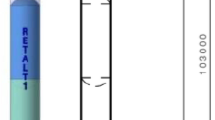Abstract
This paper compares the usual Hohmann and bielliptic geostationary transfer orbits with lunar assisted transfers. It turns out that lunar assisted transfers are more economical for any inclination greater than the Moon orbit inclination. The lunar assisted transfers based on traditional flyby are analyzed: these are characterized by high values of the Keplerian apogee distance xa. Reducing such distance, the spacecraft approaches the Moon with lower energy and the lunar gravitational help can be more effective. In fact it is shown that transfers with smaller xa, called far lunar assisted geostationary transfers, are the most economical.
Similar content being viewed by others
References
IVANISHIN, V. and TYPITSYN, N. “Use of Moon Gravitational Field to Inject a Spacecraft to Geostationary Orbit, “ Kosmicheskie Issledovaniya, Vol. 9, 1971, pp 163–172.
CASTRONUOVO, M., GRAZIANI, F., and TEOFILATTO, P. “Geostationary Orbits from Mid-Latitude Launch Sites via Lunar Gravity Assist, “ Advances in the Astronautical Sciences, Vol. 84, 1993, pp. 561–572, Univelt, San Diego.
SGUBINI, S. and TEOFILATTO, P. “Optimal Impulsive Maneuvers in Orbital Transfers, “ XV AIDAA Congress, Turin, Italy, 15–19 November 1999.
ECKEL, K. “Optimum Transfer in Central Force Field with N Impulses, “ Acta Astronautica, Vol. 9, 1963, pp. 302–324.
KAWAGUCHI, J., YAMAKAWA, H., UESUGI, T., and MATSUO, H. “On Making Use of Lunar and Solar Gravity Assist for Lunar A and Planet B Missions, “ Acta Astronautica, Vol. 35, 1999, pp. 633–642.
CIRCI, C. and TEOFILATTO, P. “On Weak Stability Boundary Lunar Transfers, “ Celestial Mechanics, Vol. 79, 2001, pp. 41–72.
OPIK, E. Interplanetary Encounters, Elsevier, Amsterdam, 1976.
BATTIN, R. An Introduction to the Mathematics and Methods of Astrodynamics, AIAA Educational Series, New York, 1987.
CARUSI, A., VALSECCHI, G., and GREENBERG, R. “Planetary Close Encounters: Geometry of Approach and Post Encounter Orbital Parameters, “ Celestial Mechanics, Vol. 49, 1990, pp. 111–131.
GREENBERG, R., CARUSI, A., and VALSECCHI, G. “Outcomes of Planetary Close Encounters: a Systematic Comparison of Methodologies, “ Icarus, Vol. 75, 1998, pp. 1–29.
EVERARH, E. “Implicit Single Sequence Methods for Integrating Orbits, “ Celestial Mechanics, Vol. 10, 1974, pp. 35–55.
TEOFILATTO, P. and DE PASQUALE, E. “A Fast Guidance Algorithm for an Autonomous Navigation System, “ Planetary and Space Science, Vol. 46, No. 11/12, 1998, pp. 1627–1632.
Author information
Authors and Affiliations
Rights and permissions
About this article
Cite this article
Circi, C., Graziani, F. & Teofilatto, P. Moon Assisted Out of Plane Maneuvers of Earth Spacecraft. J of Astronaut Sci 49, 363–383 (2001). https://doi.org/10.1007/BF03546228
Published:
Issue Date:
DOI: https://doi.org/10.1007/BF03546228




